 |
OLD WALLED TOWNS |
| << THE DISAPPEARANCE OF ENGLAND |
| IN STREETS AND LANES >> |
CHAPTER
III
OLD
WALLED TOWNS
The
destruction of ancient buildings
always causes grief and
distress to those who
love
antiquity. It is much to be deplored,
but in some cases is perhaps
inevitable.
Old-fashioned
half-timbered shops with
small diamond-paned windows
are not the
most
convenient for the display
of the elegant fashionable costumes
effectively
draped
on modelled forms. Motor-cars
cannot be displayed in antiquated
old shops.
Hence
in modern up-to-date towns
these old buildings are
doomed, and have to
give
place to grand emporiums with
large plate-glass windows and the
refinements
of
luxurious display. We hope to visit
presently some of the old
towns and cities
which
happily retain their ancient
beauties, where quaint houses
with oversailing
upper
stories still exist, and with
the artist's aid to describe
many of their
attractions.
Although
much of the destruction is,
as I have said, inevitable, a
vast amount is
simply
the result of ignorance and
wilful perversity. Ignorant
persons get elected on
town
councils--worthy men doubtless, and
able men of business, who
can attend to
and
regulate the financial
affairs of the town, look
after its supply of gas and
water,
its
drainage and tramways; but they
are absolutely ignorant of
its history, its
associations,
of architectural beauty, of anything
that is not modern and
utilitarian.
Unhappily,
into the care of such
men as these is often
confided the custody
of
historic
buildings and priceless treasures, of ruined abbey and
ancient walls, of
objects
consecrated by the lapse of
centuries and by the associations of
hundreds of
years
of corporate life; and it is not
surprising that in many
cases they betray
their
trust.
They are not interested in
such things. "Let bygones be
bygones," they say.
"We
care not for old
rubbish." Moreover, they
frequently resent interference and
instruction.
Hence they destroy wholesale
what should be preserved, and
England
is
the poorer.
Not
long ago the Edwardian
wall of Berwick-on-Tweed was
threatened with
demolition
at the hands of those who ought to be
its guardians--the Corporation
of
the
town. An official from the
Office of Works, when he saw
the begrimed,
neglected
appearance of the two
fragments of this wall near
the Bell Tower, with
a
stagnant
pool in the fosse, bestrewed with
broken pitchers and rubbish,
reported
that
the Elizabethan walls of the
town which were under
the direction of the
War
Department
were in excellent condition, whereas
the Edwardian masonry
was
utterly
neglected. And why was this
relic of the town's former
greatness to be
pulled
down? Simply to clear the
site for the erection of
modern dwelling-houses.
A
very strong protest was made
against this act of municipal
barbarism by learned
societies,
the Society for the
Preservation of Ancient Buildings, and
others, and we
hope
that the hand of the
destroyer has been
stayed.
Most
of the principal towns in
England were protected by
walls, and the
citizens
regarded
it as a duty to build them and
keep them in repair. When we
look at some
of
these fortifications, their
strength, their height,
their thickness, we are
struck by
the
fact that they were
very great achievements, and that
they must have
been
raised
with immense labour and
gigantic cost. In turbulent and
warlike times they
were
absolutely necessary. Look at some of
these triumphs of medieval
engineering
skill,
so strong, so massive, able to defy the
attacks of lance and arrow, ram
or
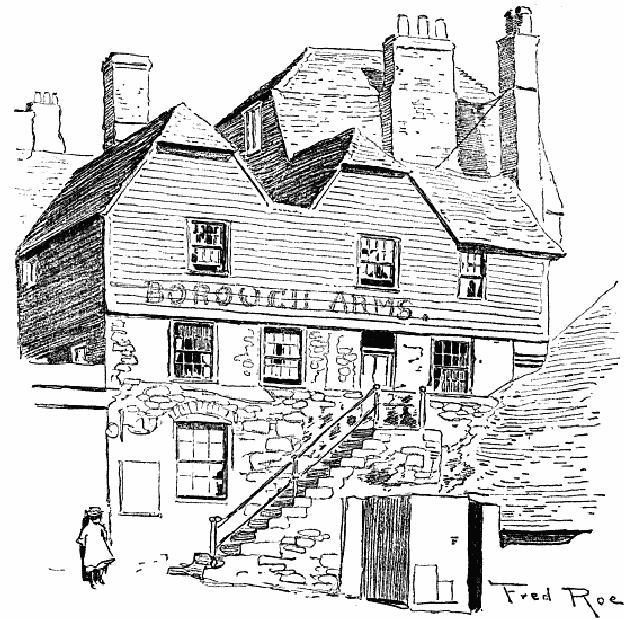
catapult,
and to withstand ages of neglect and
the storms of a tempestuous
clime.
Towers
and bastions stood at intervals against the
wall at convenient distances, in
order
that bowmen stationed in
them could shoot down
any who attempted to
scale
the
wall with ladders anywhere
within the distance between
the towers. All along
the
wall there was a protected
pathway for the defenders to stand,
and
machicolations
through which boiling oil or
lead, or heated sand could be
poured
on
the heads of the attacking
force. The gateways were
carefully constructed,
flanked
by defending towers with a
portcullis, and a guard-room overhead
with
holes
in the vaulted roof of the
gateway for pouring down
inconvenient substances
upon
the heads of the besiegers.
There were several gates,
the usual number
being
four;
but Coventry had twelve,
Canterbury six, and Newcastle-on-Tyne
seven,
besides
posterns.
Old
Houses built on the Town Wall,
Rye
Berwick-upon-Tweed,
York, Chester, and Conway
have maintained their walls
in
good
condition. Berwick has three
out of its four gates
still standing. They
are
called
Scotchgate, Shoregate, and Cowgate, and in
the last two still
remain the
original
massive wooden gates with
their bolts and hinges. The
remaining fourth
gate,
named Bridgate, has vanished. We
have alluded to the neglect
of the
Edwardian
wall and its threatened destruction.
Conway has a wall a mile and
a
quarter
in length, with twenty-one
semicircular towers along
its course and three
great
gateways besides posterns. Edward I
built this wall in order to
subjugate the
Welsh,
and also the walls round
Carnarvon, some of which
survive, and Beaumaris.
The
name of his master-mason has been
preserved, one Henry le Elreton.
The
muniments
of the Corporation of Alnwick
prove that often great
difficulties arose
in
the matter of wall-building.
Its closeness to the
Scottish border rendered a
wall
necessary.
The town was frequently
attacked and burnt. The inhabitants
obtained a
licence
to build a wall in 1433, but
they did not at once proceed
with the work. In
1448
the Scots came and pillaged
the town, and the poor
burgesses were so robbed
and
despoiled that they could
not afford to proceed with
the wall and petitioned
the
King
for aid. Then Letters Patent
were issued for a collection
to be made for the
object,
and at last, forty years after
the licence was granted,
Alnwick got its
wall,
and
a very good wall it was--a
mile in circumference, twenty
feet in height and
six
in
thickness; "it had four
gateways--Bondgate, Clayport, Pottergate,
and
Narrowgate.
Only the first-named of
these is standing. It is three stories in
height.
Over
the central archway is a
panel on which was carved
the Brabant lion,
now
almost
obliterated. On either side is a
semi-octagonal tower. The
masonry is
composed
of huge blocks to which time
and weather have given dusky
tints. On the
front
facing the expected foes the
openings are but little
more than arrow-slits;
on
that
within, facing the town,
are well-proportioned mullioned and
transomed
windows.
The great ribbed archway is
grooved for a portcullis,
now removed, and a
low
doorway on either side gives
entrance to the chambers in the
towers. Pottergate
was
rebuilt in the eighteenth
century and crowns a steep
street; only four
corner-
stones
marked T indicate the site of
Clayport. No trace of Narrowgate
remains."4
As
the destruction of many of
our castles is due to the
action of Cromwell and
the
Parliament,
who caused them to be
"slighted" partly out of
revenge upon the
loyal
owners
who had defended them, so several of
our town-walls were thrown
down by
order
of Charles II at the Restoration on
account of the active
assistance which the
townspeople
had given to the rebels. The
heads of rebels were often placed
on
gateways.
London Bridge, Lincoln,
Newcastle, York, Berwick,
Canterbury, Temple
Bar,
and other gates have often
been adorned with these gruesome
relics of
barbarous
punishments.
How
were these strong walls
ever taken in the days
before gunpowder was
extensively
used or cannon discharged their
devastating shells? Imagine
you are
present
at a siege. You would see
the attacking force
advancing a huge
wooden
tower,
covered with hides and placed on
wheels, towards the walls.
Inside this
tower
were ladders, and when the
"sow" had been pushed towards
the wall the
soldiers
rushed up these ladders and were
able to fight on a level
with the garrison.
Perhaps
they were repulsed, and then
a shed-like structure would be
advanced
towards
the wall, so as to enable the
men to get close enough to
dig a hole beneath
the
walls in order to bring them
down. The besieged would
not be inactive, but
would
cast heavy stones on the
roof of the shed. Molten lead and
burning flax were
favourite
means of defence to alarm and frighten
away the enemy, who
retaliated
by
casting heavy stones by
means of a catapult into the
town.
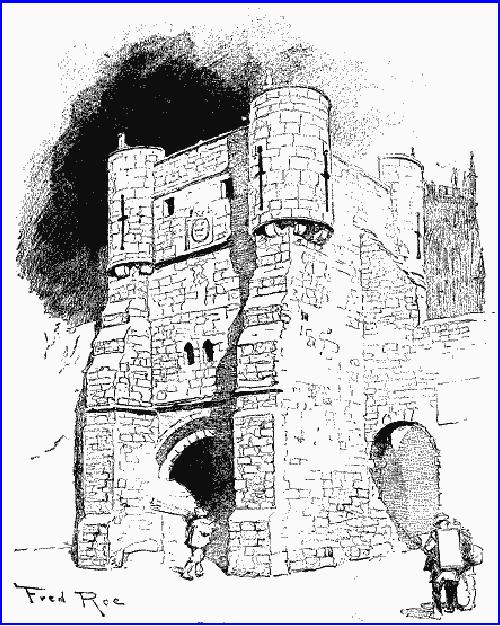
Bootham
Bar, York
Amongst
the fragments of walls still
standing, those at Newcastle are
very massive,
sooty,
and impressive. Southampton
has some grand walls
left and a gateway,
which
show how strongly the
town was fortified. The old
Cinque Port,
Sandwich,
formerly
a great and important town,
lately decayed, but somewhat
renovated by
golf,
has two gates left, and
Rochester and Canterbury have
some fragments of
their
walls standing. The repair
of the walls of towns was
sometimes undertaken by
guilds.
Generous benefactors, like
Sir Richard Whittington,
frequently contributed
to
the cost, and sometimes a tax
called murage was levied
for the purpose which
was
collected by officers named
muragers.
The
city of York has lost many
of its treasures, and the City Fathers
seem to find it
difficult
to keep their hands off such
relics of antiquity as are
left to them. There
are
few
cities in England more
deeply marked with the
impress of the storied past
than
York--the
long and moving story of
its gates and walls, of the
historical
associations
of the city through century
after century of English
history. About
eighty
years ago the Corporation
destroyed the picturesque
old barbicans of the
Bootham,
Micklegate, and Monk Bars, and
only one, Walmgate, was
suffered to
retain
this interesting feature. It is a
wonder they spared those
curious stone half-
length
figures of men, sculptured in a
menacing attitude in the act of
hurling large
stones
downwards, which vaunt
themselves on the summit of
Monk Bar--probably
intended
to deceive invaders--or that interesting
stone platform only
twenty-two
inches
wide, which was the only
foothold available for the
martial burghers who
guarded
the city wall at Tower
Place. A year or two ago
the City Fathers decided,
in
order to provide work for
the unemployed, to interfere
with the city moats
by
laying
them out as flower-beds and by
planting shrubs and making
playgrounds of
the
banks. The protest of the
Yorks Archæological Society, we
believe, stayed their
hands.
The
same story can be told of
far too many towns and
cities. A few years
ago
several
old houses were demolished
in the High Street of the
city of Rochester to
make
room for electric tramways.
Among these was the old
White Hart Inn, built
in
1396,
the sign being a badge of
Richard II, where Samuel
Pepys stayed. He found
that
"the beds were corded, and we had no
sheets to our beds, only
linen to our
mouths"
(a narrow strip of linen to
prevent the contact of the
blanket with the
face).
With
regard to the disappearance of old
inns, we must wait until we
arrive at
another
chapter.
We
will now visit some old
towns where we hope to discover
some buildings that
are
ancient and where all is
not distressingly new,
hideous, and commonplace.
First
we
will travel to the old-world
town of Lynn--"Lynn Regis, vulgarly
called King's
Lynn,"
as the royal charter of
Henry VIII terms it. On the
land side the town
was
defended
by a fosse, and there are
still considerable remains of
the old wall,
including
the fine Gothic South Gates.
In the days of its ancient
glory it was known
as
Bishop's Lynn, the town
being in the hands of the
Bishop of Norwich.
Bishop
Herbert
de Losinga built the church
of St. Margaret at the
beginning of the
twelfth
century,
and gave it with many privileges to
the monks of Norwich, who
held a
priory
at Lynn; and Bishop Turbus
did a wonderfully good stroke of
business,
reclaimed
a large tract of land about
1150 A.D., and amassed
wealth for his
see
from
his markets, fairs, and
mills. Another bishop,
Bishop Grey, induced
or
compelled
King John to grant a free
charter to the town, but
astutely managed to
keep
all the power in his
own hands. Lynn was always a very
religious place, and
most
of the orders--Benedictines, Franciscans,
Dominicans, Carmelite and
Augustinian
Friars, and the Sack
Friars--were represented at Lynn, and
there were
numerous
hospitals, a lazar-house, a college of
secular canons, and other
religious
institutions,
until they were all
swept away by the greed of a
rapacious king. There
is
not much left to-day of
all these religious
foundations. The latest
authority on the
history
of Lynn, Mr. H.J. Hillen,
well says: "Time's unpitying
plough-share has
spared
few vestiges of their architectural
grandeur."
A cemetery cross in
the
museum,
the name "Paradise" that keeps up
the remembrance of the cool,
verdant
cloister-garth,
a brick arch upon the
east bank of the Nar, and a
similar gateway in
"Austin"
Street are all the relics
that remain of the old
monastic life, save
the
slender
hexagonal "Old Tower," the
graceful lantern of the
convent of the grey-
robed
Franciscans. The above writer also points
out the beautifully carved
door in
Queen
Street, sole relic of the
College of Secular Canons, from
which the chisel of
the
ruthless iconoclast has
chipped off the obnoxious
Orate
pro anima.
The
quiet, narrow, almost
deserted streets of Lynn,
its port and quays have
another
story
to tell. They proclaim its
former greatness as one of the
chief ports in
England
and
the centre of vast
mercantile activity. A thirteenth-century
historian, Friar
William
Newburg, described Lynn as "a noble
city noted for its
trade." It was the
key
of Norfolk. Through it flowed
all the traffic to and
from northern East
Anglia,
and
from its harbour crowds of
ships carried English produce,
mainly wool, to the
Netherlands,
Norway, and the Rhine
Provinces. Who would have
thought that this
decayed
harbour ranked fourth among
the ports of the kingdom?
But its glories
have
departed. Decay set in. Its
prosperity began to
decline.
Railways
have been the ruin of
King's Lynn. The merchant
princes who once
abounded
in the town exist here no
longer. The last of the
long race died quite
recently.
Some ancient ledgers still
exist in the town, which
exhibit for one firm
alone
a turnover of something like a
million and a half sterling
per annum.
Although
possessed of a similarly splendid
waterway, unlike Ipswich,
the trade of
the
town seems to have quite
decayed. Few signs of commerce are
visible, except
where
the advent of branch
stations of enterprising "Cash"
firms has resulted in
the
squaring
up of odd projections and consequent
overthrow of certain
ancient
buildings.
There is one act of vandalism which
the town has never
ceased to regret
and
which should serve as a warning
for the future. This is
the demolition of the
house
of Walter Coney, merchant, an
unequalled specimen of
fifteenth-century
domestic
architecture, which formerly stood at
the corner of the Saturday
Market
Place
and High Street. So strongly was this
edifice constructed that it was
with the
utmost
difficulty that it was taken to
pieces, in order to make room
for the ugly
range
of white brick buildings
which now stands upon
its site. But Lynn had an
era
of
much prosperity during the
rise of the Townshends, when
the agricultural
improvements
brought about by the second
Viscount introduced much
wealth to
Norfolk.
Such buildings as the Duke's
Head Hotel belong to the
second Viscount's
time,
and are indicative of the
influx of visitors which the
town enjoyed. In the
present
day this hotel, though
still a good-sized establishment, occupies
only half
the
building which it formerly
did. An interesting oak staircase of
fine proportions,
though
now much warped, may be
seen here.
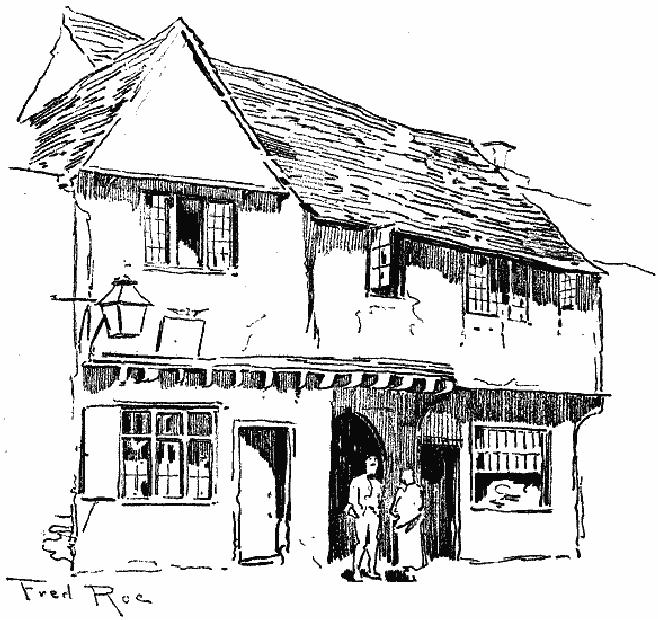
Half-timbered
House with early
Fifteenth-century Doorway, King's
Lynn, Norfolk
In
olden days the Hanseatic League had an
office here. The Jews
were plentiful and
supplied
capital--you can find their
traces in the name of the
"Jews' Lane Ward"--
and
then came the industrious
Flemings, who brought with
them the art of
weaving
cloth
and peculiar modes of building houses, so
that Lynn looks almost like
a little
Dutch
town. The old guild
life of Lynn was strong and vigorous,
from its Merchant
Guild
to the humbler craft guilds,
of which we are told that
there have been no
less
than
seventy-five. Part of the old
Guildhall, erected in 1421,
with its chequered
flint
and
stone gable still stands facing
the market of St. Margaret
with its Renaissance
porch,
and a bit of the guild
hall of St. George the
Martyr remains in King
Street.
The
custom-house, which was
originally built as an exchange
for the Lynn
merchants,
is a notable building, and has a statue
of Charles II placed in a niche.
This
was the earliest work of a
local architect, Henry Bell,
who is almost
unknown.
He
was mayor of King's Lynn, and
died in 1717, and his memory
has been saved
from
oblivion by Mr. Beloe of that
town, and is enshrined in Mr.
Blomfield's
History
of Renaissance Architecture:--
"This
admirable little building
originally consisted of an open
loggia
about
40 feet by 32 feet outside,
with four columns down
the centre,
supporting
the first floor, and an
attic storey above. The
walls are of
Portland
stone, with a Doric order to
the ground storey supporting
an
Ionic
order to the first floor.
The cornice is of wood, and
above this is a
steep-pitched
tile roof with dormers,
surmounted by a balustrade
inclosing
a flat, from which rises a
most picturesque wooden
cupola.
The
details are extremely
refined, and the technical
knowledge and
delicate
sense of scale and proportion
shown in this building
are
surprising
in a designer who was under thirty, and
is not known to have
done
any previous work."5
A
building which the town
should make an effort to preserve is the
old "Greenland
Fishery
House," a tenement dating
from the commencement of the
seventeenth
century.
The
Duke's Head Inn, erected in
1689, now spoilt by its
coating of plaster, a house
in
Queen's Street, the old market cross,
destroyed in 1831 and sold for
old
materials,
and the altarpieces of the
churches of St. Margaret and
St. Nicholas,
destroyed
during "restoration," and
North Runcton church, three
miles from Lynn,
are
other works of this very
able artist.
Until
the Reformation Lynn was known as
Bishop's Lynn, and galled
itself under
the
yoke of the Bishop of
Norwich; but Henry freed
the townsfolk from
their
bondage
and ordered the name to be changed to Lynn Regis.
Whether the good
people
throve better under the
control of the tyrant who
crushed all their guilds
and
appropriated
the spoil than under
the episcopal yoke may be
doubtful; but the
change
pleased them, and with
satisfaction they placed the
royal arms on their
East
Gate,
which, after the manner of
gates and walls, has been
pulled down. If you
doubt
the former greatness of this
old seaport you must
examine its civic plate.
It
possesses
the oldest and most
important and most beautiful specimen of
municipal
plate
in England, a grand, massive silver-gilt
cup of exquisite workmanship. It
is
called
"King John's Cup," but it
cannot be earlier than the
reign of Edward III. In
addition
to this there is a superb sword of
state of the time of Henry
VIII, another
cup,
four silver maces, and other
treasures. Moreover, the town had a
famous
goldsmiths'
company, and several specimens of
their handicraft remain.
The
defences
of the town were sorely
tried in the Civil War,
when for three weeks
it
sustained
the attacks of the rebels. The
town was forced to surrender, and
the poor
folk
were obliged to pay ten
shillings a head, besides a
month's pay to the
soldiers,
in
order to save their homes
from plunder. Lynn has many
memories. It sheltered
King
John when fleeing from
the revolting barons, and kept
his treasures until
he
took
them away and left them in a
still more secure place
buried in the sands of
the
Wash.
It welcomed Queen Isabella
during her retirement at Castle
Rising,
entertained
Edward IV when he was hotly
pursued by the Earl of
Warwick, and has
been
worthy of its name as a loyal
king's town.
Another
walled town on the Norfolk
coast attracts the attention
of all who love
the
relics
of ancient times, Great
Yarmouth, with its wonderful
record of triumphant
industry
and its associations with many great
events in history. Henry
III,
recognizing
the important strategical
position of the town in
1260, granted a
charter
to
the townsfolk empowering
them to fortify the place
with a wall and a moat,
but
more
than a century elapsed
before the fortifications
were completed. This
was
partly
owing to the Black Death,
which left few men in
Yarmouth to carry on
the
work.
The walls were built of
cut flint and Caen stone, and
extended from the
north
-east
tower in St. Nicholas
Churchyard, called King
Henry's Tower, to
Blackfriars
Tower
at the south end, and
from the same King
Henry's Tower to the
north-west
tower
on the bank of the Bure.
Only a few years ago a large
portion of this, north
of
Ramp
Row, now called Rampart
Road, was taken down, much
to the regret of
many.
And here I may mention a
grand movement which might
be with advantage
imitated
in every historic town. A
small private company has
been formed called
the
"Great Yarmouth Historical
Buildings, Limited." Its
object is to acquire and
preserve
the relics of ancient
Yarmouth. The founders
deserve the highest praise
for
their
public spirit and patriotism. How
many cherished objects in
Vanishing
England
might have been preserved if
each town or county
possessed such a
valuable
association! This Yarmouth society
owns the remains of the
cloisters of
Grey
Friars and other remains of
ancient buildings. It is only to be
regretted that it
was
not formed earlier. There
were nine gates in the
walls of the town, but
none of
them
are left, and of the sixteen
towers which protected the
walls only a very
few
remain.
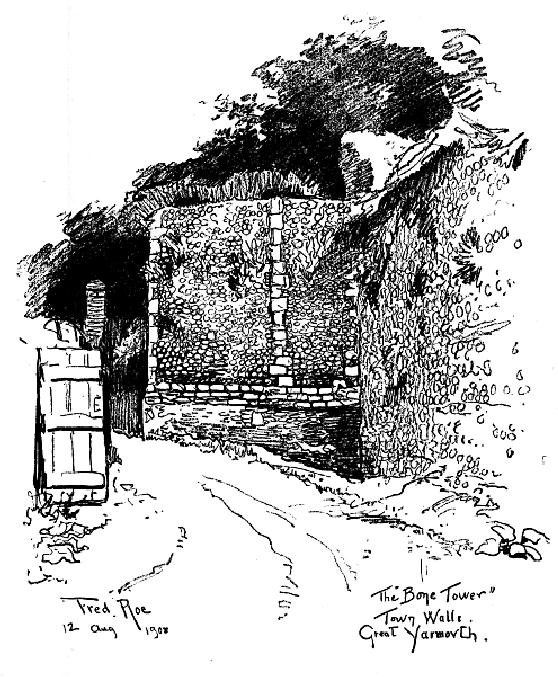
The
"Bone Tower", Town walls,
Great Yarmouth
These
walls guard much that is
important. The ecclesiastical buildings
are very
fine,
including the largest parish
church in England, founded by
the same Herbert
de
Losinga whose good work we saw at
King's Lynn. The church of
St. Nicholas
has
had many vicissitudes, and is now one of
the finest in the country.
It was in
medieval
times the church of a
Benedictine Priory; a cell of
the monastery at
Norwich
and the Priory Hall remains,
and is now restored and used as a
school.
Royal
guests have been entertained
there, but part of the
buildings were turned
into
cottages
and the great hall into stables. As we
have said, part of the
Grey Friars
Monastery
remains, and also part of the house of
the Augustine Friars.
The
Yarmouth
rows are a great feature of
the town. They are
not like the Chester
rows,
but
are long, narrow streets
crossing the town from
east to west, only six
feet wide,
and
one row called Kitty-witches
only measures at one end two
feet three inches. It
has
been suggested that this
plan of the town arose
from the fishermen hanging
out
their
nets to dry and leaving a narrow
passage between each other's
nets, and that in
course
of time these narrow
passages became defined and
were permanently
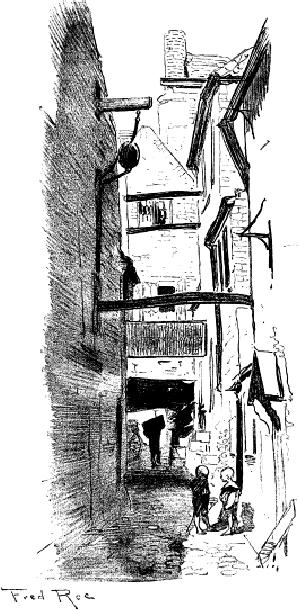
retained.
In former days rich merchants and traders
lived in the houses that
line
these
rows, and had large gardens
behind their dwellings; and sometimes
you can
see
relics of former greatness--a
panelled room or a richly decorated
ceiling. But
the
ancient glory of the rows is
past, and the houses are
occupied now by
fishermen
or
labourers. These rows are so
narrow that no ordinary
vehicle could be
driven
along
them. Hence there arose
special Yarmouth carts about three and a
half feet
wide
and twelve feet long
with wheels underneath the
body. Very brave and
gallant
have
always been the fishermen of
Yarmouth, not only in
fighting the elements,
but
in
defeating the enemies of
England. History tells of
many a sea-fight in which
they
did
good service to their king and
country. They gallantly
helped to win the
battle
of
Sluys, and sent forty-three ships and one
thousand men to help with
the siege of
Calais
in the time of Edward III.
They captured and burned
the town and harbour
of
Cherbourg
in the time of Edward I, and
performed many other acts of
daring.
Row
No. 83, Great
Yarmouth
One
of the most interesting
houses in the town is the
Tolhouse, the centre of
the
civic
life of Yarmouth. It is said to be
six hundred years old,
having been erected
in
the
time of Henry III, though
some of the windows are
decorated, but may
have
been
inserted later. Here the
customs or tolls were
collected, and the
Corporation
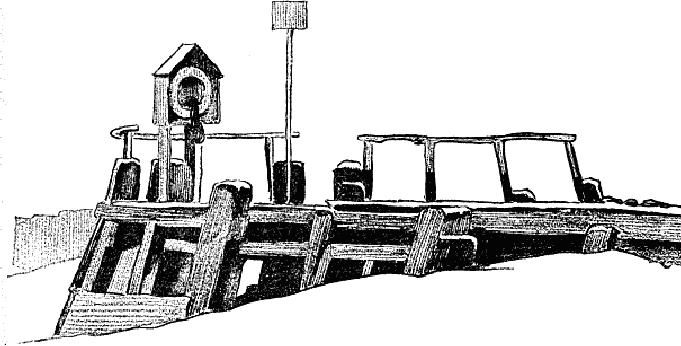
held
its meetings. There is a
curious open external staircase
leading to the first
floor,
where the great hall is
situated. Under the hall is
a gaol, a wretched
prison
wherein
the miserable captives were
chained to a beam that ran
down the centre.
Nothing
in the town bears stronger
witness to the industry and perseverance
of the
Yarmouth
men than the harbour.
They have scoured the sea
for a thousand years to
fill
their nets with its spoil,
and made their trade of world-wide
fame, but their
port
speaks
louder in their praise.
Again and again has the
fickle sea played havoc
with
their
harbour, silting it up with
sand and deserting the
town as if in revenge for
the
harvest
they reap from her.
They have had to cut out no
less than seven harbours
in
the
course of the town's existence,
and royally have they
triumphed over all
difficulties
and made Yarmouth a great and prosperous
port.
Near
Yarmouth is the little port
of Gorleston with its old
jetty-head, of which we
give
an illustration. It was once the rival of
Yarmouth. The old
magnificent church
of
the Augustine Friars stood in
this village and had a
lofty, square,
embattled
tower
which was a landmark to sailors.
But the church was unroofed
and despoiled
at
the Reformation, and its
remains were pulled down in
1760, only a small
portion
of
the tower remaining, and
this fell a victim to a
violent storm at the
beginning of
the
last century. The grand
parish church was much
plundered at the
Reformation,
and
left piteously bare by the
despoilers.
The
Old Jetty, Gorleston
The
town, now incorporated with
Yarmouth, has a proud
boast:--
Gorleston
was Gorleston ere Yarmouth
begun,
And
will be Gorleston when Yarmouth is
done.
Another
leading East Anglian port in
former days was the county
town of Suffolk,
Ipswich.
During the thirteenth and
fourteenth centuries ships from
most of the
countries
of Western Europe disembarked their
cargoes on its quays--wines
from
Spain,
timber from Norway, cloth
from Flanders, salt from
France, and "mercerie"
from
Italy left its crowded
wharves to be offered for
sale in the narrow, busy
streets
of
the borough. Stores of fish
from Iceland, bales of wool,
loads of untanned hides,
as
well as the varied
agricultural produce of the
district, were exposed twice
in the
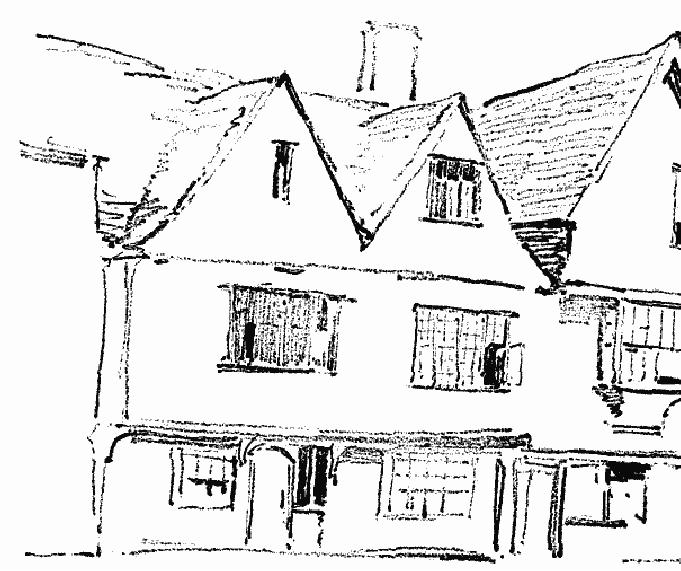
week
on the market stalls.6
The
learned editor of the
Memorials
of Old Suffolk,
who
knows
the old town so well,
tells us that the stalls of
the numerous markets
lay
within
a narrow limit of space near
the principal churches of
the town--St. Mary-le
-Tower,
St. Mildred, and St.
Lawrence. The Tavern Street of
to-day was the site of
the
flesh market or cowerye. A
narrow street leading thence to
the Tower Church
was
the Poultry, and Cooks' Row,
Butter Market, Cheese and
Fish markets were in
the
vicinity. The manufacture of
leather was the leading
industry of old
Ipswich,
and
there was a goodly company of
skinners, barkers, and tanners employed
in the
trade.
Tavern Street had, as its name
implies, many taverns, and was
called the
Vintry,
from the large number of
opulent vintners who carried
on their trade with
London
and Bordeaux. Many of these
men were not merely
peaceful merchants,
but
fought with Edward III in
his wars with France and
were knighted for
their
feats
of arms. Ipswich once boasted of a castle
which was destroyed in
Stephen's
reign.
In Saxon times it was fortified by a
ditch and a rampart which
were
destroyed
by the Danes, but the
fortifications were renewed in
the time of King
John,
when a wall was built round
the town with four
gates which took their
names
from
the points of the compass.
Portions of these remain to
bear witness to the
importance
of this ancient town. We
give views of an old
building near the
custom-
house
in College Street and Fore Street,
examples of the narrow,
tortuous
thoroughfares
which modern improvements
have not swept
away.
Tudor
House, Ipswich, near the
Custom House
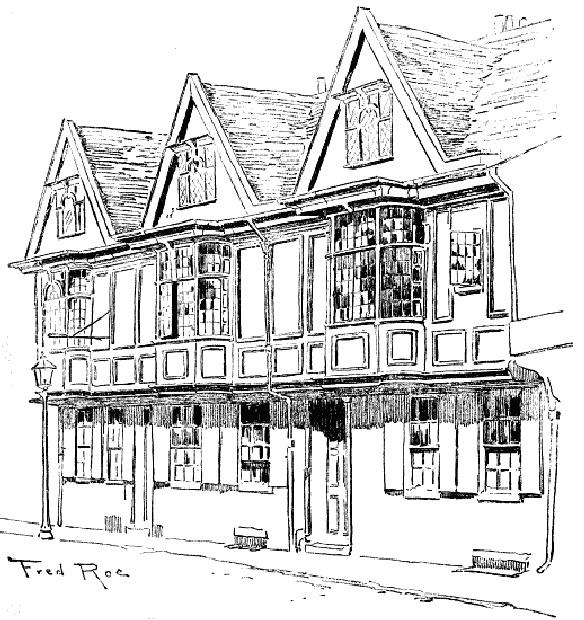
Three-gabled
House, Fore Street,
Ipswich
We
cannot give accounts of all
the old fortified towns in
England and can only
make
selections. We have alluded to
the ancient walls of York.
Few cities can
rival
it
in interest and architectural beauty,
its relics of Roman times,
its stately and
magnificent
cathedral, the beautiful
ruins of St. Mary's Abbey,
the numerous
churches
exhibiting all the grandeur
of the various styles of
Gothic architecture,
the
old
merchants' hall, and the
quaint old narrow streets
with gabled houses and
widely
projecting storeys. And then
there is the varied history
of the place dating
from
far-off Roman times. Not
the least interesting feature of York
are its gates and
walls.
Some parts of the walls are
Roman, that curious
thirteen-sided building
called
the multangular tower
forming part of it, and also
the lower part of the
wall
leading
from this tower to Bootham
Bar, the upper part
being of later origin.
These
walls
have witnessed much
fighting, and the cannons in
the Civil War during
the
siege
in 1644 battered down some portions of
them and sorely tried their
hearts.
But
they have been kept in good
preservation and repaired at times, and
the part on
the
west of the Ouse is especially
well preserved. You can see
some Norman and
Early
English work, but the
bulk of it belongs to Edwardian
times, when York
played
a great part in the history of
England, and King Edward I
made it his capital
during
the war with Scotland, and
all the great nobles of
England sojourned
there.
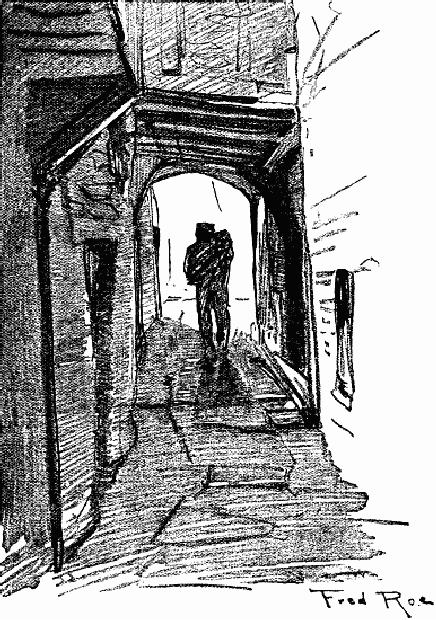
Edward
II spent much time there, and
the minster saw the marriage
of his son.
These
walls were often sorely
needed to check the inroads
of the Scots. After
Bannockburn
fifteen thousand of these
northern warriors advanced to the
gates of
York.
The four gates of the
city are very remarkable.
Micklegate Bar consists of a
square
tower built over a circular
arch of Norman date with
embattled turrets at
the
angles.
On it the heads of traitors
were formerly exposed. It bears on
its front the
arms
of France as well as those of
England.
"Melia's
Passage," York
Bootham
Bar is the main entrance
from the north, and has a
Norman arch with
later
additions
and turrets with narrow
slits for the discharge of
arrows. It saw the
burning
of the suburb of Bootham in 1265 and
much bloodshed, when a
mighty
quarrel
raged between the citizens
and the monks of the Abbey
of St. Mary owing
to
the abuse of the privilege
of sanctuary possessed by the
monastery. Monk Bar
has
nothing to do with monks.
Its former name was
Goodramgate, and after
the
Restoration
it was changed to Monk Bar in honour of
General Monk. The
present
structure
was probably built in the
fourteenth century. Walmgate
Bar, a strong,
formidable
structure, was built in the
reign of Edward I, and as we have said,
it is
the
only gate that retains
its curious barbican,
originally built in the time
of Edward
III
and rebuilt in 1648. The
inner front of the gate
has been altered from
its original
form
in order to secure more
accommodation within. The
remains of the
Clifford's
Tower,
which played an important
part in the siege, tell of
the destruction
caused
by
the blowing up of the
magazine in 1683, an event
which had more the
appearance
of design than accident. York abounds
with quaint houses and
narrow
streets.
We give an illustration of the
curious Melia's Passage; the
origin of the
name
I am at a loss to conjecture.
Chester
is, we believe, the only
city in England which has
retained the entire
circuit
of
its walls complete.
According to old unreliable legends,
Marius, or Marcius,
King
of the British, grandson of
Cymbeline, who began his
reign A.D. 73,
first
surrounded
Chester with a wall, a mysterious person
who must be classed
with
Leon
Gawr, or Vawr, a mighty
strong giant who founded
Chester, digging
caverns
in
the rocks for habitations,
and with the story of King
Leir, who first made
human
habitations
in the future city. Possibly
there was here a British camp. It
was
certainly
a Roman city, and has
preserved the form and plan
which the Romans
were
accustomed to affect; its four
principal streets diverging at
right angles from a
common
centre, and extending north,
east, south, and west, and
terminating in a
gate,
the other streets forming
insulæ as at Silchester. There is
every reason to
believe
that the Romans surrounded
the city with a wall.
Its strength was
often
tried.
Hither the Saxons came under
Ethelfrith and pillaged the
city, but left it to
the
Britons,
who were not again dislodged
until Egbert came in 828 and
recovered it.
The
Danish pirates came here and
were besieged by Alfred, who
slew all within
its
walls.
These walls were standing
but ruinous when the
noble daughter of
Alfred,
Ethelfleda,
restored them in 907. A volume
would be needed to give a full
account
of
Chester's varied history, and our
main concern is with the
treasures that
remain.
The
circumference of the walls is
nearly two miles, and there
are four principal
gates
besides posterns--the North,
East, Bridge-gate, and Water-gate.
The North
Gate
was in the charge of the
citizens; the others were
held by persons who had
that
office
by serjeanty under the Earls
of Chester, and were entitled to
certain tolls,
which,
with the custody of the
gates, were frequently purchased by
the Corporation.
The
custody of the Bridge-gate
belonged to the Raby family
in the reign of
Edward
III.
It had two round towers, on
the westernmost of which was an
octagonal water-
tower.
These were all taken down in
1710-81 and the gate
rebuilt. The East
Gate
was
given by Edward I to Henry
Bradford, who was bound to
find a crannoc and a
bushel
for measuring the salt
that might be brought in.
Needless to say, the old
gate
has
vanished. It was of Roman architecture,
and consisted of two arches formed
by
large
stones. Between the tops of the arches,
which were cased with
Norman
masonry,
was the whole-length figure of a
Roman soldier. This gate was
a porta
principalis,
the termination of the great
Watling Street that led from
Dover through
London
to Chester. It was destroyed in 1768, and
the present gate erected by
Earl
Grosvenor.
The custody of the
Water-gate belonged to the
Earls of Derby. It also
was
destroyed, and the present arch
erected in 1788. A new North
Gate was built in
1809
by Robert, Earl Grosvenor.
The principal postern-gates were Cale
Yard Gate,
made
by the abbot and convent in the
reign of Edward I as a passage to
their
kitchen
garden; New-gate, formerly
Woolfield or Wolf-gate, repaired in 1608,
also
called
Pepper-gate;7
and
Ship-gate, or Hole-in-the-wall, which
alone retains its
Roman
arch, and leads to a ferry
across the Dee.
The
walls are strengthened by
round towers so placed as not to be
beyond bowshot
of
each other, in order that
their arrows might reach the
enemy who should
attempt
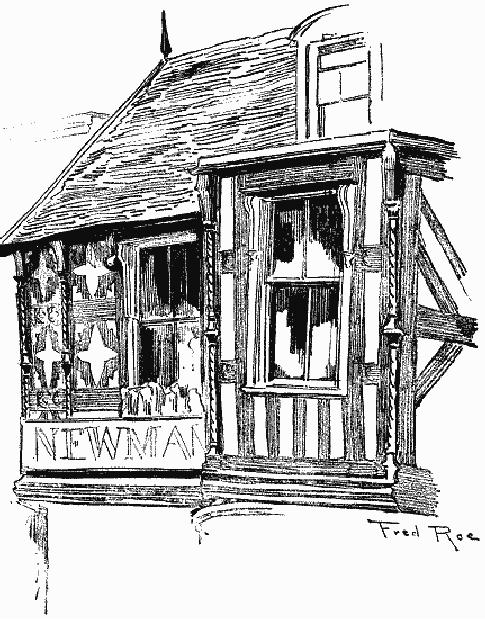
to
scale the walls in the
intervals. At the north-east
corner is Newton's
Tower,
better
known as the Phoenix from a
sculptured figure, the
ensign of one of the
city
guilds,
appearing over its door.
From this tower Charles I
saw the battle of
Rowton
Heath
and the defeat of his troops
during the famous siege of
Chester. This was one
of
the most prolonged and
deadly in the whole history
of the Civil War. It
would
take
many pages to describe the
varied fortunes of the
gallant Chester men,
who
were
at length constrained to feed on horses,
dogs, and cats. There is
much in the
city
to delight the antiquary and
the artist--the famous rows,
the three-gabled old
timber
mansion of the Stanleys with
its massive staircase, oaken floors,
and
panelled
walls, built in 1591, Bishop
Lloyd's house in Water-gate with
its timber
front
sculptured with Scripture
subjects, and God's Providence House
with its
motto
"God's Providence is mine
inheritance," the inhabitants of
which are said to
have
escaped one of the terrible plagues
that used to rage frequently
in old Chester.
Detail
of Half-timbered House in High
Street, Shrewsbury
Journeying
southwards we come to Shrewsbury, another
walled town,
abounding
with
delightful half-timbered houses, less
spoiled than any town we
know. It was
never
a Roman town, though six
miles away, at Uriconium,
the Romans had a
flourishing
city with a great basilica,
baths, shops, and villas, and the
usual
accessories
of luxury. Tradition says
that its earliest Celtic
name was Pengwern,
where
a British prince had his palace;
but the town Scrobbesbyrig
came into
existence
under Offa's rule in Mercia,
and with the Normans came
Roger de
Montgomery,
Shrewsbury's first Earl, and
a castle and the stately abbey of
SS.
Peter
and Paul. A little later the
town took to itself walls,
which were abundantly
necessary
on account of the constant
inroads of the wild
Welsh.
For
the barbican's massy and high,
Bloudie
Jacke!
And
the oak-door is heavy and
brown;
And
with iron it's plated
and machicolated,
To
pour boiling oil and lead
down;
How
you'd frown
Should
a ladle-full fall on your
crown!
The
rock that it stands on is
steep,
Bloudie
Jacke!
To
gain it one's forced for to
creep;
The
Portcullis is strong, and the
Drawbridge is long,
And
the water runs all
round the Keep;
At
a peep
You
can see that the moat's very
deep!
So
rhymed the author of the
Ingoldsby
Legends, when in
his "Legend of
Shropshire"
he described the red stone fortress
that towers over the
loop of the
Severn
enclosing the picturesque
old town of Shrewsbury. The
castle, or rather its
keep,
for the outworks have
disappeared, has been
modernized past
antiquarian
value
now. Memories of its
importance as the key of the
Northern Marches, and of
the
ancient custom of girding
the knights of the shire
with their swords by
the
sheriffs
on the grass plot of its
inner court, still remain.
The town now stands on
a
peninsula
girt by the Severn. On the
high ground between the
narrow neck stood
the
castle, and under its shelter
most of the houses of the
inhabitants. Around
this
was
erected the first wall.
The latest historian of
Shrewsbury8
tells us
that it started
from
the gate of the castle,
passed along the ridge at
the back of Pride Hill, at
the
bottom
of which it turned along the
line of High Street, past
St. Julian's Church
which
overhung it, to the top of
Wyle Cop, when it followed
the ridge back to the
castle.
Of the part extending from
Pride Hill to Wyle Cop only scant traces
exist at
the
back of more modern
buildings.
The
town continued to grow and
more extensive defences were
needed, and in the
time
of Henry III, Mr. Auden states
that this followed the
old line at the back
of
Pride
Hill, but as the ground
began to slope downwards, another
wall branched
from
it in the direction of Roushill and
extended to the Welsh
Bridge. This became
the
main defence, leaving the
old wall as an inner
rampart. From the Welsh
Bridge
the
new wall turned up Claremont
Bank to where St. Chad's
Church now stands,
and
where one of the original
towers stood. Then it passed
along Murivance,
where
the
only existing tower is to be
seen, and so along the still
remaining portion of
the
wall
to English Bridge, where it
turned up the hill at the
back of what is now
Dogpole,
and passing the Watergate,
again joined the fortifications of
the castle.9
The
castle itself was reconstructed by Prince
Edward, the son of Henry III, at
the
end
of the thirteenth century,
and is of the Edwardian type
of concentric castle. The
Norman
keep was incorporated within a
larger circle of tower and
wall, forming an
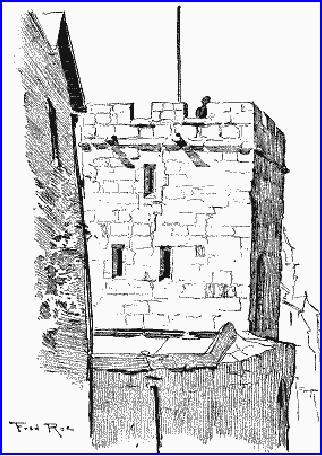
inner
bailey; besides this there
was formerly an outer bailey, in
which were various
buildings,
including the chapel of St.
Nicholas. Only part of the
buildings on one
side
of the inner bailey remains
in its original form, but
the massive character of the
whole
may be judged from the
fragments now
visible.
These
walls guarded a noble town full of
churches and monasteries,
merchants'
houses,
guild halls, and much else.
We will glance at the beauties
that remain: St.
Mary's,
containing specimens of every
style of architecture from
Norman
downward,
with its curious foreign
glass; St. Julian's, mainly
rebuilt in 1748,
though
the old tower remains;
St. Alkmund's; the Church of
St. Chad; St.
Giles's
Church;
and the nave and refectory
pulpit of the monastery of
SS. Peter and Paul.
It
is
distressing to see this
interesting gem of fourteenth-century
architecture amid the
incongruous
surroundings of a coalyard. You can find
considerable remains of
the
domestic
buildings of the Grey
Friars' Monastery near the
footbridge across the
Severn,
and also of the home of the
Austin Friars in a builder's
yard at the end of
Baker
Street.
Tower
on the Town Wall,
Shrewsbury
In
many towns we find here and
there an old half-timbered
dwelling, but in
Shrewsbury
there is a surprising wealth of
them--streets full of them, bearing
such
strange
medieval names as "Mardel" or
"Wyle Cop." Shrewsbury is
second to no
other
town in England in the
interest of its ancient
domestic buildings. There is
the
gatehouse
of the old Council House,
bearing the date 1620,
with its high gable
and
carved
barge-boards, its panelled front,
the square spaces between
the upright and
horizontal
timbers being ornamented
with cut timber. The
old buildings of the
famous
Shrewsbury School are now
used as a Free Library and
Museum and
abound
in interest. The house remains in
which Prince Rupert stayed
during his
sojourn
in 1644, then owned by
"Master Jones the lawyer,"
at the west end of
St.
Mary's
Church, with its fine
old staircase. Whitehall, a
fine mansion of red
sandstone,
was built by Richard Prince, a
lawyer, in 1578-82, "to his
great chardge
with
fame to hym and hys
posterite for ever." The
Old Market Hall in
the
Renaissance
style, with its mixture of
debased Gothic and classic details, is
worthy
of
study. Even in Shrewsbury we
have to record the work of
the demon of
destruction.
The erection of the New
Market Hall entailed the
disappearance of
several
old picturesque houses. Bellstone
House, erected in 1582, is
incorporated in
the
National Provincial Bank.
The old mansion known as
Vaughan's Place is
swallowed
up by the music-hall, though
part of the ancient
dwelling-place remains.
St.
Peter's Abbey Church in the
commencement of the nineteenth
century had an
extraordinary
annexe of timber and plaster,
probably used at one time as
parsonage
house,
which, with several buttressed
remains of the adjacent
conventual buildings,
have
long ago been squared up
and "improved" out of
existence. Rowley's
mansion,
in
Hill's Lane, built of brick
in 1618 by William Rowley, is now a
warehouse.
Butcher
Row has some old
houses with projecting
storeys, including a
fine
specimen
of a medieval shop. Some of
the houses in Grope Lane
lean together from
opposite
sides of the road, so that people in
the highest storey can
almost shake
hands
with their neighbours across
the way. You can see the
"Olde House" in
which
Mary Tudor is said to have
stayed, and the mansion of the
Owens, built in
1592
as an inscription tells us, and
that of the Irelands, with
its range of bow-
windows,
four storeys high, and
terminating in gables, erected
about 1579. The
half
-timbered
hall of the Drapers' Guild,
some old houses in
Frankwell, including
the
inn
with the quaint sign--the
String of Horses, the ancient
hostels--the Lion,
famous
in the coaching age, the
Ship, and the
Raven--Bennett's Hall, which
was
the
mint when Shrewsbury played
its part in the Civil
War, and last, but not
least,
the
house in Wyle Cop, one of the
finest in the town, where
Henry Earl of
Richmond
stayed on his way to Bosworth
field to win the English
Crown. Such are
some
of the beauties of old
Shrewsbury which happily
have not yet
vanished.
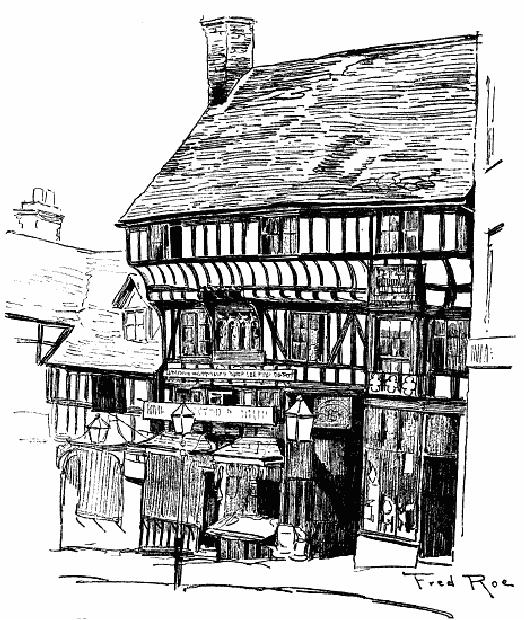
House
that the Earl of Richmond
stayed in before the Battle of
Bosworth,
Shrewsbury
Not
far removed from Shrewsbury
is Coventry, which at one time
could boast of a
city
wall and a castle. In the reign of
Richard II this wall was
built, strengthened by
towers.
Leland, writing in the time
of Henry VIII, states that
the city was begun
to
be
walled in when Edward II
reigned, and that it had six
gates, many fair
towers,
and
streets well built with
timber. Other writers speak
of thirty-two towers and
twelve
gates. But few traces of
these remain. The citizens
of Coventry took an
active
part in the Civil War in
favour of the Parliamentary
army, and when
Charles
II
came to the throne he ordered
these defences to be demolished.
The gates were
left,
but most of them have since
been destroyed. Coventry is a
city of fine old
timber-framed
fifteenth-century houses with
gables and carved barge-boards and
projecting
storeys, though many of them
are decayed and may not
last many years.
The
city has had a fortunate
immunity from serious fires. We
give an illustration of
one
of the old Coventry streets
called Spon Street, with its
picturesque houses.
These
old streets are numerous,
tortuous and irregular. One of
the richest and most
interesting
examples of domestic architecture in
England is St. Mary's Hall,
erected
in
the time of Henry VI. Its
origin is connected with
ancient guilds of the city,
and
in
it were stored their books and archives.
The grotesquely carved roof,
minstrels'
gallery,
armoury, state-chair, great painted
window, and a fine specimen of
fifteenth-century
tapestry are interesting
features of this famous
hall, which
furnishes
a vivid idea of the manners
and civic customs of the age
when Coventry
was
the favourite resort of
kings and princes. It has
several fine churches,
though
the
cathedral was levelled with
the ground by that
arch-destroyer Henry VIII.
Coventry
remains one of the most
interesting towns in
England.
One
other walled town we will
single out for especial
notice in this
chapter--the
quaint,
picturesque, peaceful, placid
town of Rye on the Sussex
coast. It was once
wooed
by the sea, which surrounded
the rocky island on which it
stands, but the
fickle
sea has retired and
left it lonely on its hill
with a long stretch of
marshland
between
it and the waves. This must
have taken place about the
fifteenth century.
Our
illustration of a disused mooring-post
(p. 24) is a symbol of the
departed
greatness
of the town as a naval
station. The River Rother
connects it with the
sea,
and
the few barges and humble
craft and a few small
shipbuilding yards remind
it
of
its palmy days when it was a
member of the Cinque Ports,
a rich and prosperous
town
that sent forth its ships to
fight the naval battles of
England and win
honour
for
Rye and St. George. During
the French wars English
vessels often visited
French
ports and towns along the
coast and burned and pillaged
them. The French
sailors
retaliated with equal zest,
and many of our southern
towns have suffered
from
fire and sword during those
adventurous days.
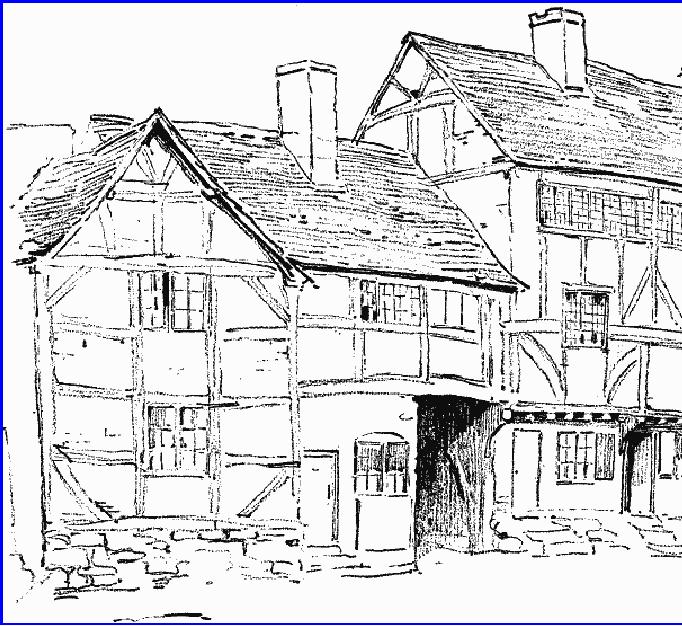
Old
Houses formerly standing in Spon Street
Coventry
Rye
was strongly fortified by a wall
with gates and towers
and a fosse, but the
defences
suffered grievously from the
attacks of the French, and the
folk of Rye
were
obliged to send a moving
petition to King Richard II,
praying him "to
have
consideration
of the poor town of Rye,
inasmuch as it had been
several times taken,
and
is unable further to repair
the walls, wherefore the
town is, on the
sea-side,
open
to enemies." I am afraid that
the King did not at once
grant their petition,
as
two
years later, in 1380, the
French came again and set
fire to the town. With
the
departure
of the sea and the
diminishing of the harbour,
the population
decreased
and
the prosperity of Rye
declined. Refugees from France have on
two notable
occasions
added to the number of its
inhabitants. After the
Massacre of St.
Bartholomew
seven hundred scared and frightened
Protestants arrived at Rye and
brought
with them their industry,
and later on, after the
Revocation of the Edict
of
Nantes,
many Huguenots settled here and
made it almost a French
town. We need
not
record all the royal
visits, the alarms of
attack, the plagues, and other
incidents
that
have diversified the life of
Rye. We will glance at the
relics that remain.
The
walls
seem never to have recovered
from the attack of the
French, but one gate
is
standing--the
Landgate on the north-east of the
town, built in 1360, and
consisting
of
a broad arch flanked by two massive
towers with chambers above for
archers
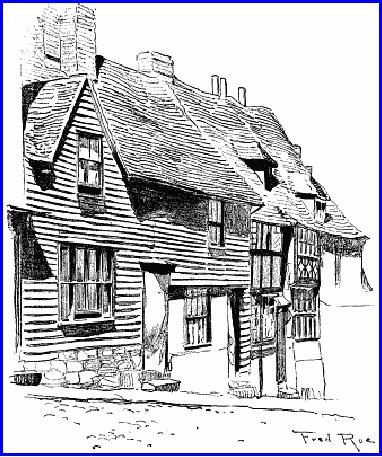
and
defenders. Formerly there were
two other gates, but
these have vanished
save
only
the sculptured arms of the
Cinque Ports that once adorned the
Strand Gate.
The
Ypres tower is a memorial of
the ancient strength of the
town, and was
originally
built by William de Ypres,
Earl of Kent, in the twelfth
century, but has
received
later additions. It has a
stern, gaunt appearance, and
until recent times
was
used
as a jail. The church
possesses many points of
unique interest. The
builders
began
in the twelfth century to
build the tower and transepts,
which are Norman;
then
they proceeded with the
nave, which is Transitional; and
when they reached
the
choir, which is very large
and fine, the style had
merged into the Early
English.
Later
windows were inserted in the
fourteenth and fifteenth centuries.
The church
has
suffered with the town at
the hands of the French
invaders, who did
much
damage.
The old clock, with
its huge swinging pendulum,
is curious. The
church
has
a collection of old books, including
some old Bibles, including a
Vinegar and a
Breeches
Bible, and some stone
cannon-balls, mementoes of the French
invasion of
1448.
West
Street, Rye
Near
the church is the Town Hall,
which contains several
relics of olden days.
The
list
of mayors extends from the
time of Edward I, and we notice
the long
continuance
of the office in families.
Thus the Lambs held
office from 1723 to
1832,
and the Grebells from 1631 to
1741. A great tragedy happened in
the
churchyard.
A man named Breedes had a grudge against
one of the Lambs, and
intended
to kill him. He saw, as he
thought, his victim walking
along the dark
path
through
the shrubs in the
churchyard, attacked and murdered
him. But he had made
a
mistake; his victim was Mr.
Grebell. The murderer was
hanged and quartered.
The
Town Hall contains the
ancient pillory, which was
described as a very
handy
affair,
handcuffs, leg-irons, special constables' staves,
which were always
much
needed
for the usual riots on
Gunpowder Plot Day, and
the old primitive
fire-engine
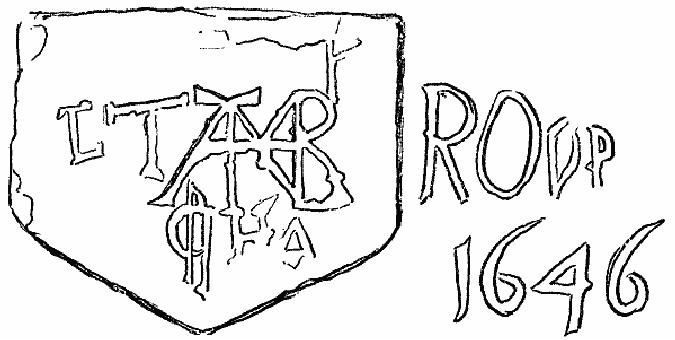
dated
1745. The town has
some remarkable plate. There
is the mayor's
handbell
with
the inscription:--
O
MATER DEI
MEMENTO
MEI.
1566.
PETRUS
GHEINEUS
ME
FECIT.
The
maces of Queen Elizabeth
with the date 1570
and bearing the fleur-de-lis
and
the
Tudor rose are interesting,
and the two silver maces
presented by George III,
bearing
the arms of Rye and weighing 962
oz., are said to be the
finest in Europe.
Monogram
and Inscription in the Mermaid
Inn, Rye
The
chief charm of Rye is to
walk along the narrow
streets and lanes, and see
the
picturesque
rows and groups of old
fifteenth-and sixteenth-century houses
with
their
tiled roofs and gables, weather-boarded
or tile-hung after the
manner of
Sussex
cottages, graceful bay-windows--altogether
pleasing. Wherever one
wanders
one meets with these
charming dwellings, especially in
West Street and
Pump
Street; the oldest house in
Rye being at the corner of
the churchyard. The
Mermaid
Inn is delightful both outside
and inside, with its
low panelled rooms,
immense
fire-places and dog-grates. We see the
monogram and names and
dates
carved
on the stone fire-places, 1643,
1646, the name Loffelholtz seeming
to
indicate
some foreign refugee or
settler. It is pleasant to find at least in one
town in
England
so much that has been
left unaltered and so little
spoilt.
Table of Contents:
- INTRODUCTION
- THE DISAPPEARANCE OF ENGLAND
- OLD WALLED TOWNS
- IN STREETS AND LANES
- OLD CASTLES
- VANISHING OR VANISHED CHURCHES
- OLD MANSIONS
- THE DESTRUCTION OF PREHISTORIC REMAINS
- CATHEDRAL CITIES AND ABBEY TOWNS
- OLD INNS
- OLD MUNICIPAL BUILDINGS
- OLD CROSSES
- STOCKS AND WHIPPING-POSTS
- OLD BRIDGES
- OLD HOSPITALS AND ALMSHOUSES
- VANISHING FAIRS
- THE DISAPPEARANCE OF OLD DOCUMENTS
- OLD CUSTOMS THAT ARE VANISHING
- THE VANISHING OF ENGLISH SCENERY
- CONCLUSION